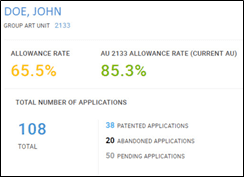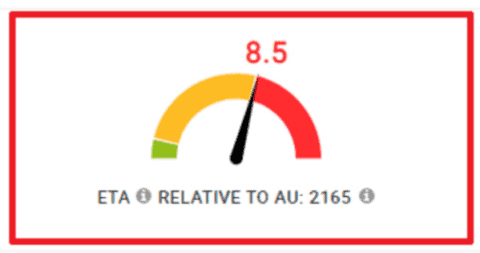Using Statistics to Gather Patent Examiner Intel

Patent professionals maintain an interesting relationship with their assigned patent examiners. From one perspective, it is perfectly amicable. Patent examiners are generally cooperative and unbiased; they stick to examining procedure, and even if the rejections they issue end up reducing the scope of a patent’s protection, it often becomes stronger in the process. The flip side of this relationship is that USPTO patent examiners are also obstacles that must be overcome before a patent will issue. Most patent examiners do not harbor a vendetta against patent applicants, but USPTO patent examiners do vary quite drastically from one another in their experience levels, predispositions and difficulties relative to other examiners. No matter which view you take on your patent examiner, USPTO patent and statistics – patent examiner intel – can help you better understand them and can help the patent process play out as smoothly as possible.
Patent examiner intel: patent prosecution history
Historical patent data can paint a vivid picture of a patent examiner’s career at the USPTO. Patent statistics, such as an examiner’s allowance rate or the average office actions they issue per patent application, can help patent practitioners manage client expectations and devise appropriate patent prosecution strategies. However, most patent statistics are presented as career averages, and patent examiner decisions can trend up or down at different points in their careers. As a result, patent professionals can learn a lot from USPTO patent statistics, but each statistic should be taken with a dose of caution and context before it is relied on.

Predicting a patent examiner’s future actions
Where career patent statistics fail in their ability to predict the future, more advanced patent examiner intel metrics have the potential to succeed. The best patent metric for predicting examiner behavior is currently the PatentAdvisor ETA™, which is based on a proprietary algorithm that factors in the circumstances surrounding each patent examiner. The PatentAdvisor ETA patent metric is unique in that it takes into account each patent examiner’s experience level, their trends in decision–making and the actions they have recently taken on patent applications that are still pending (not just those that have been granted or abandoned). Examiners with low ETA values are preferable to patent applicants, and patent professionals who face patent examiners with high ETA values should buckle up for a lengthy and challenging journey.

Determining the present course of action in patent prosecution
What good is predicting the future if nothing can be done about it? Knowing you are up against a difficult patent examiner is helpful to an extent, but USPTO patent data can also be used to identify the best actions for a patent professional to take to successfully and efficiently navigate patent prosecution. For example, USPTO patent statistics can show us when an early appeal could avoid responding to several additional office actions, while also offering the best opportunity for receiving a patent. Patent statistics can also reveal key insights, such as that a patent examiner has historically responded well to Requests for Continued Examination (RCEs) or to something as simple as an interview, which can make a positive impact on the patent process.
Patent data is a powerful tool for understanding each patent examiner, whether friend or foe. The LexisNexis PatentAdvisor® patent analytics platform communicates information to its users that adds clarity and detail about the USPTO employees who determine the fates of patent applications. Whether looking retroactively at an examiner’s track record, predicting their future or developing a patent prosecution strategy, PatentAdvisor™ users can lean on patent statistics and proprietary metrics to prosecute efficiently and effectively.
Learn more about PatentAdvisor.
Explore more on how to use patent examiner intel data to understand USPTO examiners.
For more on patent examiner intel watch the on-demand webinar Patent Prosecution Analytics: No Longer Just a Nice to Have and read the overview here.

Need more predictability in the patent prosecution process?
Learn how to develop successful IP strategies and proficiently manage patent applications throughout the entire prosecution process using data-driven insights and advanced analytics.
